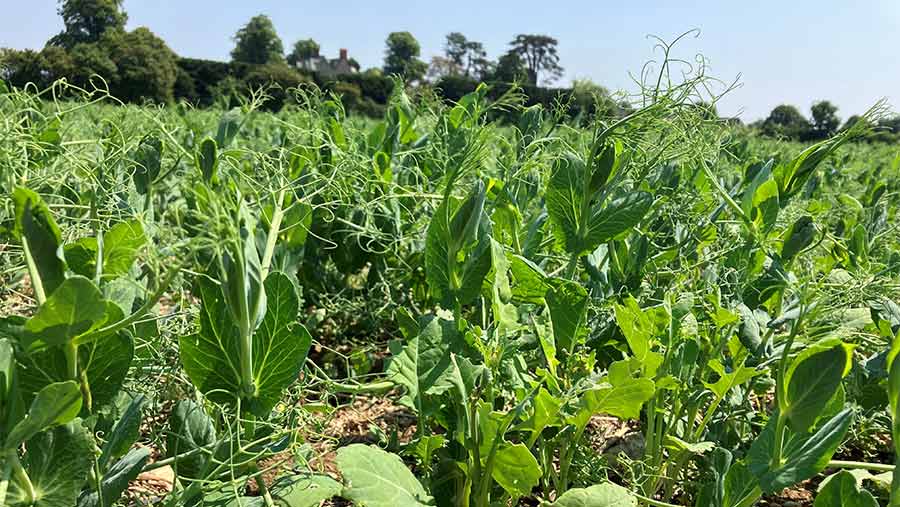Why increasing diversity in arable fields is key to IPM
 © MAG/Emma Gillbard
© MAG/Emma Gillbard Introducing greater diversity in arable fields is an important part of integrated strategies for disease and pest control, buying crucial time for slower acting biological solutions.
Canadian soil specialist Joel Williams says that while monocultures have some advantages like ease of management, this uniformity means farmers have a large area of something that is susceptible to a particular disease or pest.
See also: Why a fish-based soil improver may help plant growth
Once the disease or pest is present, it can spread easily because it is surrounded by potential hosts.
One approach within an integrated approach is to break this monoculture up and design a system with diversity.
Layers of diversity
Joel says there are three layers of diversity:
- Time (rotation) – still grow monocultures, but with different plants over time
- Spatial – the next level up is physical separation between plants, such as intercropping
- Genetics – growing a mix of different varieties.
The first layer is rotation, where monocultures are still grown, but with diversity over time to help reduce the build-up of pests and diseases.
Farmers are already doing this, but they can widen their rotations and have a mix of winter and spring cropping, cover crops or introduce more novel cash crops, he says.
“It’s about doing something different to what you are already doing. So, if you have annual crops, can you bring in some perennials?”
The second is spatial, concerning the physical separation of plants by other plant types. Pathogens are always present and if plants are susceptible, they will cause disease.
And if those plants are surrounded by other susceptible hosts, disease will rapidly spread. But if half are non-hosts, it slows down the spread.
The third layer is genetic diversity, which can be achieved with variety blends that have different genetic resistance.
There is an opportunity to combine these layers and Joel points to Dutch work in potatoes looking at late blight, specifically the period of disease build-up.
In a monoculture, levels exceeded the threshold to cause disease within four days.
When introducing 6m strips of alternate potato varieties, this delayed it to six days. Alternating 3m strips saw it take a bit over 10 days to reach threshold.
At the next level, introducing mixed cultivars (blends) saw this rise to 16 days with 6m strips and more than 20 days when combined with 3m strips.
“This shows that combining spatial and genetic diversity can slow it down. Just a few days’ grace can mean a lot.”
This gives the other integrated strategies a chance to work.
“Some are not as quick-acting, especially some of the biological approaches,” Joel says.
It’s not just extra time, greater crop diversity brings benefits of a greater range of pathogens.
He points to another study on disease pressure looking at 1-60 plant species. As you increase the host plant diversity, there are more diverse pathogens.
But the ability to cause disease is falling, as it is having a dilution effect.
“So you are seeing more pathogen species, but they are unable to cause economic damage.”
It’s a similar story with pests, with a review of 351 studies showing that as the number of plant species increases, pest abundance decreases while the number of beneficials rises.
Intercropping
For arable growers, one practical way to increase diversity in the field is by intercropping.
Joel points to a review of 101 studies. In 79% of the trials, the researchers saw disease suppression with intercropping.
“Sometimes, they saw an increase, but in nearly 80% of the trials they saw a reduction.”
In a similar review looking at pests, 68% of the 153 studies saw a reduction.
However, one caveat is nematodes. “You need to be careful, as diversity seems to increase numbers.”
He says it is the one thing that can get worse and suggests that farmers may need to look at biofumigant crops to minimise any effects from increasing plant diversity.
Other benefits of diversity
Greater plant diversity can bring benefits to soil, improving structure as well as releasing locked-up nutrients.
Canadian soil expert Joel Williams highlighted a UK study comparing a cover crop of clover, black oats, tillage radish and phacelia.
It showed that black oats resulted in the highest soil pore connectivity compared with other species, whereas phacelia decreased porosity.
But phacelia is good at stimulating soil fungi, so by having both in a mix, you get both benefits.
Brassicas and legumes also complement each other. Brassicas are good at scavenging nitrogen and are used to prevent nitrate leaching.
In one trial, a brassica/legume mix was compared with a straight brassica and researchers found they achieved the same level of nitrate capture by reducing soil mineral N by an average of 59%, despite being fewer brassica plants.
Multifunctionality
That’s because the legume had a green manuring effect, adding nitrogen into the system. This equated to an extra 22kg/ha of N, and Joel says is an example of multifunctionality.
There are similar multifunctional effects with intercropping. With a cereal/legume intercrop, there are different roots and different root exudates, so 1+1=3.
For example, lupins cause maize to increase the release of organic acid exudates from roots, so they are better at scavenging phosphorus than monoculture maize.
“The presence of lupins changes how maize grows and it becomes more efficient at phosphorus uptake.”
A similar benefit is seen from a mix of maize and faba beans, with their different root exudates.
Faba beans with their acidic root exudates can unlock organic and iron forms of phosphate and are better at scavenging these than maize with its neutral exudates.
However, with calcium phosphate, maize has a competitive edge. Therefore, different plants have different specialities, which can complement each other.

